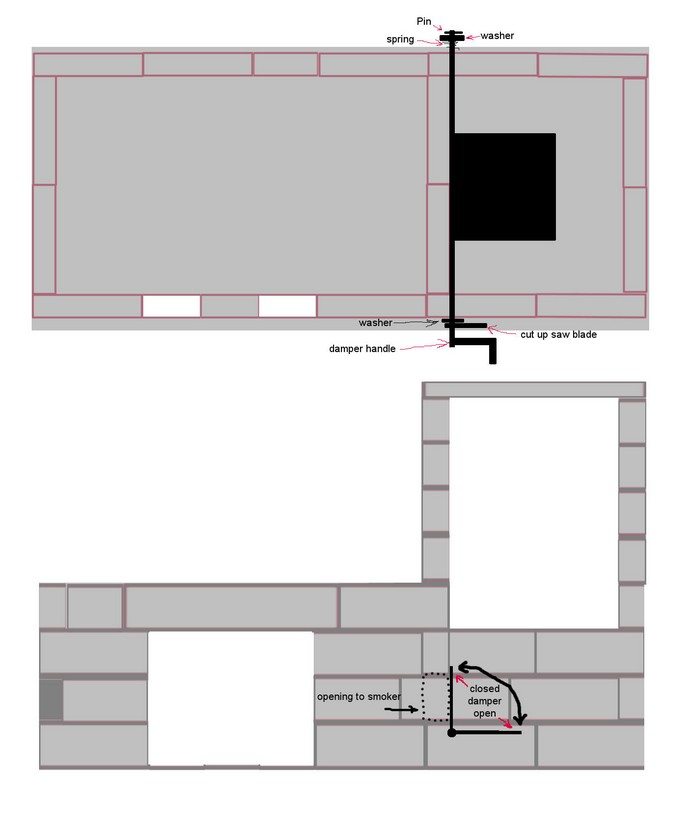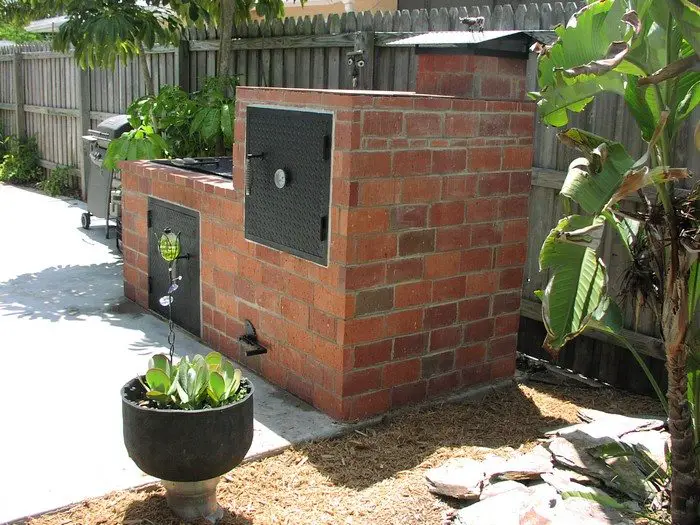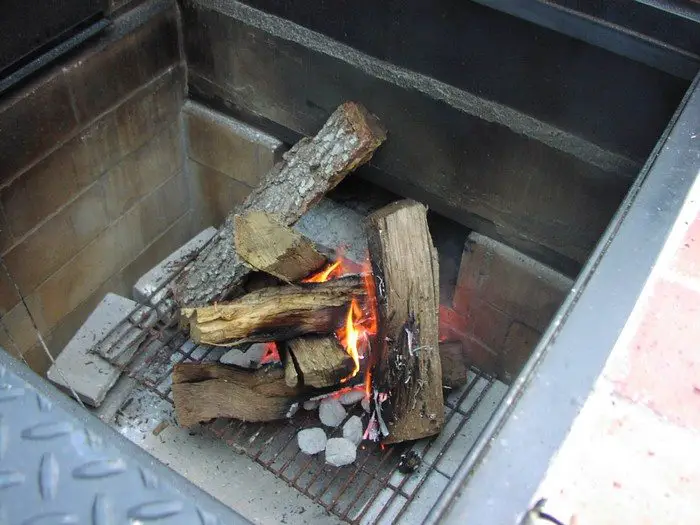
The springs for the handles on the back of smoker and grill doors are from the seat of a riding lawnmower (the riding lawn mower is now a racing mower of sorts, no use for these springs any longer) I used these to keep the tension on the handle to make them operate properly. Some flat steel bent to act as a latch on the inside of the door frame keeps the doors closed rather nice.
Finished off with a nice large easy to read temp gauge.

Damper Setup: A photo and some crude drawings to help illustrate how I set up the intake damper.

The exhaust damper is nothing more then a flat piece of steel slid over the chimney to regulate heat flow.

Sole’s Pit Master Barbecue: Among other names, LOL.
I have kept my fires small so far. Only some light grilling and short test run with the smoker. Making sure it dries out slowly.

One cheap Gas Grill on its way out the door. needs a gas bottle, first, come takes it, LOL.

Updates: What a great summer of outdoor grilling it has been! The smoker keeps a nice even temp once warmed up which does not take long! I have smoked several pork shoulders and ribs, including beef ribs and a brisket and more yard bird then I can remember!

The fire pit has been awesome as well! Appetizers like bacon-wrapped shrimp to grilled stuffed jalapenos, grilled fruit, veggies, corn, taters, you name it! All turns out great!


Editor’s note: I’d be tempted to add a removable plate above the grill racks so that I could fry onions or cook dosa etc., but other than that, I think it’s a great job! What do you say?
Thanks to solelord for this great project!
Contents
Fuel Types and Efficiency
When building and enjoying a brick barbecue, one of your key decisions involves selecting the right fuel type. Specific fuel can impact the taste of your grilled meat, vegetable kebab, or pizzas. Each fuel type offers unique benefits and considerations.
Let’s explore the options for brick barbecue enthusiasts, focusing on wood, charcoal, and gas.
Wood
Wood is the most traditional fuel used in brick barbecues, prized for the authentic smoky flavor it imparts to food. Hardwoods like oak, hickory, or mesquite are preferred for their long burning times and aromatic smoke.
While wood can be more labor-intensive to prepare and maintain at the right temperature, its ability to enhance the taste of meats and vegetables is unparalleled. Brick barbecue owners who prioritize flavor and enjoy the fire management process will find wood an excellent choice.
Charcoal
Charcoal is another popular option for brick barbecues, balancing ease of use and flavor. Briquettes provide consistent heat and are easier to light and maintain than wood. Lump charcoal, made from hardwood, offers a closer experience to wood with a slightly easier handling experience.
Charcoal’s predictability makes it a go-to for those seeking control over their cooking temperatures. It is ideal for a wide range of dishes from slow-smoked meats to quick-grilled vegetables on a brick barbecue.
Gas
Gas is an attractive option for brick barbecue enthusiasts looking for convenience and precision. Though it lacks the traditional smoky flavor associated with wood and charcoal, gas allows for instant heat control with the turn of a knob.
This fuel type is efficient, clean-burning, and ideal for those who frequently entertain or prefer a straightforward cooking process. Incorporating a gas burner into a brick barbecue design can offer the best of both worlds: quick and precise heat when you need it, with the option to use wood or charcoal for flavoring specific dishes.
Selecting the right fuel type for your brick barbecue depends on several factors, including your flavor preferences, cooking style, and environmental considerations. Wood and charcoal are excellent for authentic barbecue taste and the joy of fire management, while gas offers convenience and precision. Regardless of your choice, each fuel type can be used efficiently within a brick barbecue to create memorable meals and experiences.
Accessory Integration
Integrating accessories into your brick barbecue design elevates the cooking experience and enhances functionality and versatility. From built-in thermometers to smoking boxes, the right accessories can transform a simple brick barbecue into a culinary powerhouse.
Let’s delve into how you can incorporate various accessories to maximize the potential of your brick barbecue.
Thermometers
A built-in thermometer is an essential accessory for any brick barbecue enthusiast aiming for precision in cooking. Monitoring the temperature inside your grill or smoker ensures meats are perfectly cooked, with that desirable tender inside and crispy outside.
Installing a high-quality, easy-to-read thermometer directly into the brickwork can provide accurate readings at a glance, making it easier to manage your cooking temperatures and achieve consistent results.
Smoking Boxes
For those who love the rich, smoky flavor in their barbecued foods, incorporating a smoking box into your brick barbecue setup is a game-changer. Filled with wood chips of various flavors, such as apple, cherry, or hickory, smoking boxes slowly release smoke as they heat up, infusing your food with depth and complexity. Positioning a smoking box within your brick structure allows for easy access and control, enriching the taste of your dishes without overwhelming them.
Rotisseries
A rotisserie attachment can be a fantastic addition to a brick barbecue, especially for cooking large cuts of meat or whole poultry. Rotating the food over the heat source ensures even cooking and browning. Installing a rotisserie in your brick barbecue can be as simple as setting up a motorized spit above the grill, allowing you to slow-roast foods to perfection with minimal effort.
Grilling Racks and Baskets
Expanding your cooking surfaces with additional grilling racks and baskets can significantly increase the versatility of your brick barbecue. Adjustable racks allow for cooking at different heights, catering to various heat requirements.
Baskets are ideal for smaller items that might otherwise fall through the grates, such as vegetables or seafood. Customizing your brick barbecue with these accessories ensures that you can cook a wide array of dishes simultaneously, making the most of your outdoor cooking space.
Griddle Plate
A griddle plate can significantly expand the types of cuisine you can prepare on your brick barbecue. Perfect for breakfast items like pancakes and eggs, or for searing fish and grilling sandwiches, a griddle plate provides a flat cooking surface that diversifies your outdoor cooking options.
Vegetable Basket
A vegetable basket is designed for grilling smaller items that might otherwise fall through the grates, such as chopped vegetables or shrimp. It ensures even cooking and easy turning, making it easier to incorporate a variety of sides into your barbecue menu.
Drip Pans
Drip pans are essential for maintaining a clean brick barbecue and cooking with indirect heat. They catch drippings from your meat, preventing flare-ups and cleaning your barbecue. Additionally, the collected juices can create flavorful sauces and gravies.
Pizza Stone
A pizza stone can transform your brick barbecue into an outdoor pizza oven. A pizza stone’s high heat retention and distribution properties are perfect for achieving a crispy crust and evenly cooked toppings. It’s an excellent addition for those who enjoy artisan pizzas with the smoky flavor only a brick barbecue can provide.
Tool Hooks
Integrating tool hooks on the side of your brick barbecue ensures that your grilling tools are always within reach. This convenient addition helps keep your cooking area organized and can enhance the efficiency of your grilling process.
Lighting Solutions
For those who love to barbecue well into the evening, installing lighting solutions around your brick barbecue is a practical upgrade. LED lights or solar-powered lanterns can be placed strategically to illuminate your cooking area, ensuring you can see what you’re doing no matter the time of day.
Integrating these accessories into your brick barbecue makes the cooking process more enjoyable and elevates the quality of your culinary creations. Whether it’s achieving the perfect temperature, infusing smoky flavors, ensuring even cooking, or maximizing cooking surfaces, the right accessories can transform your brick barbecue into an outdoor kitchen worthy of a chef.
FAQ on Building a Brick Barbecue
What materials do I need to build a brick barbecue?
How do I choose the right location for my brick barbecue?
Can I build a brick barbecue myself, or do I need professional help?
How long does it take to build a brick barbecue?
What is the best fuel type for a brick barbecue?
Conclusion
Building a brick barbecue offers an exceptional outdoor cooking experience, blending tradition with versatility. It becomes a centerpiece for gatherings, encouraging the exploration of diverse culinary techniques and flavors. The durability and aesthetic appeal of brick barbecues enhance outdoor spaces, making them a worthwhile investment for enthusiasts and families alike.
For more unique barbecue ideas, check out our combo barbecue grill and table project!





